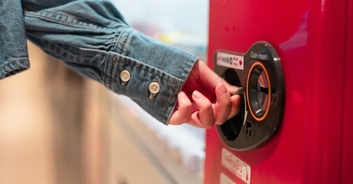Between the early 1950's and 2015, humans produced over 8.3 billion tons of plastic trash, according to a study by the University of Georgia. Of that total waste, 9 percent was recycled, 12 percent was incinerated, and 79 percent - 6.3 billion tons of plastic - was just thrown away, accumulating in landfills and the natural environment.
Plastic, the material used everyday for grocery bags, water bottles, and glitter, takes decades, some say even centuries, to biodegrade. After we throw that virtually indestructible litter away, it becomes microplastics, tiny particles of polymer-type materials less than five millimetres in length. These microplastics make their way to the ocean, where they are consumed by plankton, fish and birds, killing them.
Scientists know that we have a plastic problem, which poses a serious threat both to the environment and marine life. In Indonesia, researchers discovered six kilos of non-organic material inside a dead whale. Near the border of Thailand and Malaysia, a whale died after mistakenly ingesting up to 80 plastic bags. Some scientists have even called for a worldwide ban on glitter, because those festive little pieces of plastic collect in sea creature's stomachs, causing them to die of starvation.
However, researchers from the University of Newcastle discovered that this problem is more serious than previously thought. Under the Sky Ocean Rescue Project, Dr. Alan Jamieson led a team into the farthest depths of the ocean, exploring the Mariana Trench, the Japan Trench, the Atacama Trench, the New Hebrides Trench and the Kermadec Trench. In each trench, they collected crustaceans, and 72 percent of the crustaceans they studied had plastic in their stomachs.
To make matters worse, the scientists discovered that the deeper they ventured into the ocean, the more plastic they found. For example, at a depth of 36,000 feet in the Marina trench, 100% of the crustaceans they studied had plastic particles in their stomachs. These startling results were published in Royal Society Open Science.
"The deep sea is not only the ultimate sink for any material that descends from the surface, but it is also inhabited by organisms well adapted to a low food environment and these will often eat just about anything," Dr. Alan Jamieson said in a Newcastle University press release.
"If you contaminate a river, it can be flushed clean. If you contaminate a coastline, it can be diluted by the tides. But, in the deepest point of the oceans, it just sits there," he explained in a second press release. "Once these plastics reach the deep-seafloor there is simply nowhere else for them to go, therefore it is assumed they will simply accumulate in greater quantities - this is a very worrying find."
"The more you think about it, the more depressing it is," Jamieson added.
Many people go through daily life, bagging groceries, drinking water bottles and applying cosmetic glitter, without ever thinking about where that plastic ends up.












